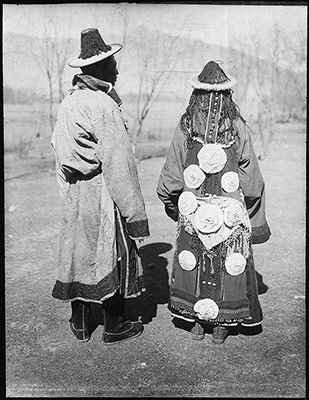
1998.285.313.2 (Lantern Slide)


1998.285.313.2 (Lantern Slide)

Rabden Lepcha
Sir Charles Bell
End of March or early April 1921
Lhasa >
1998.285.313.2
81 x 81 mm
Lantern Slide
Donated 1983
St Antony's College, Oxford.
Sir Charles Bell's Mission to Lhasa 1920-21
Royal Central Asiatic Society
Rabden Lepcha
L.262
BL.H.284
Manual Catalogues - Bell's List of Illustrations entry: "[No. of chapter] LI. [Subject of Chapter] Tribes to the East [Subject of Illustration] H.284 Golok man and his wife, back view. On the woman's back large engraved discs of silver; turquoises and corals down her hair. [Remarks] L.262 (Y in L)"
Notes on print/mount - '30' has been written in blue-black ink. This slide seems to have been used as slide 30 in the lecture 'A Year in Lhasa', which was first presented at the Royal Geographical Society on 3rd December 1923. The text, with a lesser number of images, was later published in The Geographical Journal of February 1924. Bell may also have presented this lecture on other occasions about which we have no information at present. [MS 7/9/2004]
Other Information - Cultural Background: Entry from Bell's diary for 4th April 1921 [pp. 76-77]: ‘Rabden, though at last successful, has found great difficulty in getting the Golokpas [?] to allow him to photograph them. “They are men of power (wang-chem-po)” he says; “When I ask them to let me take their photographs, they refuse curtly, saying that there is no such custom with them”. Palhese tells me that the Golokpas are prosperous as a rule, for besides trading in other districts they gain wealth by robbing outsiders in their own. In Lhasa a Golok man will sometimes snatch something off a stall in the market and make a bolt for it. Such are usually captured, but sometimes effect an escape with their booty. The people of Nya-rong are also much given to robbery, ranking perhaps second among Tibetan tribes in this respect, the Golokpas being first’ [MS 1/6/2004]
For Citation use:
The Tibet Album.
"Golok man and his wife"
05 Dec. 2006. The Pitt Rivers Museum.
<http://tibet.prm.ox.ac.uk/photo_1998.285.313.2.html>.
For more information about photographic usage or to order prints, please visit the The Pitt Rivers Museum.
© The Pitt Rivers Museum